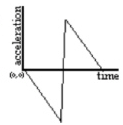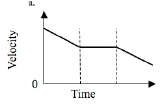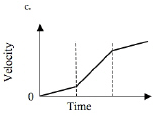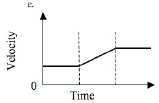
AP Physics 1D Kinematics Review
Quiz
•
Physics
•
11th Grade
•
Practice Problem
•
Hard
Standards-aligned
Michael Frankenhoff
Used 414+ times
FREE Resource
Enhance your content in a minute
14 questions
Show all answers
1.
MULTIPLE CHOICE QUESTION
2 mins • 1 pt
An object is moving in a circle with constant speed. Which of the following is/are true?
I. The object has constant velocity
II. The object has nonzero acceleration
III. After one revolution, the magnitude of the displacement is a positive value.
I only
II only
III only
I and II only
II and III only
2.
MULTIPLE CHOICE QUESTION
2 mins • 1 pt
An ideal elastic rubber ball is dropped from a height of about 2 meters, hits the floor and rebounds to its original height.Which of the following graphs would best represent acceleration versus time for the bouncing ball?




Tags
NGSS.HS-PS2-1
3.
MULTIPLE CHOICE QUESTION
2 mins • 1 pt

The following three questions relate to two objects that start at x = 0 at t = 0 and move in one dimension independently of one another. Graphs, of the velocity of each object versus time are shown below.
Which object moves with constant non-zero acceleration?
A
B
Both
Neither
Tags
NGSS.HS-PS2-1
4.
MULTIPLE CHOICE QUESTION
2 mins • 1 pt

The graph above shows the velocity versus time for an object moving in a straight line. At what time after t = 0 does the object again pass through its initial position?
Between 0 and 1
1 s
Between 1 and 2 s
2s
Between 2 and 3 s
5.
MULTIPLE CHOICE QUESTION
2 mins • 1 pt
Consider a ball thrown up from the surface of the earth into the air at an angle of 30° above the horizontal. Air friction is negligible. Just after the ball is released, its acceleration is:
0 m/s2
Upwards at 9.8 m/s2
Downwards at 9.8 m/s2
Upwards at 4.9 m/s2
None of these
Tags
NGSS.HS-PS2-1
6.
MULTIPLE CHOICE QUESTION
2 mins • 1 pt

At time t = 0, car X traveling with speed v0 passes car Y which is just starting to move. Both cars then travel on two parallel lanes of the same straight road. The graphs of speed v versus time t for both cars are shown above. Which of the following is true at time t = 20 seconds?
Car X is accelerating faster than car Y.
Car Y is passing car X.
Car Y is in front of car X.
Car Y is behind car X
Tags
NGSS.HS-PS2-1
7.
MULTIPLE CHOICE QUESTION
2 mins • 1 pt

Above is a graph of the distance vs. time for car moving along a road. According the graph, at which of the following times would the automobile have been accelerating positively?
5, 29, & 57 min.
5, 12, 29, & 35 min.
12, 35, & 41 min.
0, 20, 38, & 60 min
Tags
NGSS.HS-PS2-1
Create a free account and access millions of resources
Create resources
Host any resource
Get auto-graded reports

Continue with Google

Continue with Email

Continue with Classlink

Continue with Clever
or continue with

Microsoft
%20(1).png)
Apple
Others
Already have an account?
Similar Resources on Wayground

10 questions
ENGLISH
Quiz
•
KG - University

12 questions
Light Spectra and what it can tell us
Quiz
•
9th - 12th Grade

13 questions
Physics O Level: Light and Electromagnetic wave
Quiz
•
10th - 11th Grade

11 questions
P.3.2.2.1 The photoelectric effect
Quiz
•
11th - 12th Grade

15 questions
Quiz Competition-Hope Probe (Emirates Mars Mission)
Quiz
•
KG - 12th Grade

16 questions
Electricity Quiz
Quiz
•
KG - University

10 questions
BEST PRACTICE: Accelerated Motion
Quiz
•
10th - 12th Grade

10 questions
Waves Practice Quiz
Quiz
•
8th - 11th Grade
Popular Resources on Wayground

10 questions
Honoring the Significance of Veterans Day
Interactive video
•
6th - 10th Grade

9 questions
FOREST Community of Caring
Lesson
•
1st - 5th Grade

10 questions
Exploring Veterans Day: Facts and Celebrations for Kids
Interactive video
•
6th - 10th Grade

19 questions
Veterans Day
Quiz
•
5th Grade

14 questions
General Technology Use Quiz
Quiz
•
8th Grade

25 questions
Multiplication Facts
Quiz
•
5th Grade

15 questions
Circuits, Light Energy, and Forces
Quiz
•
5th Grade

19 questions
Thanksgiving Trivia
Quiz
•
6th Grade
Discover more resources for Physics

14 questions
Bill Nye Waves
Interactive video
•
9th - 12th Grade

14 questions
Work, Energy and Power
Lesson
•
10th - 12th Grade

10 questions
Exploring the Phenomenon of Static Electricity
Interactive video
•
9th - 12th Grade

10 questions
Newton's Third Law
Quiz
•
7th - 11th Grade

10 questions
Impulse-Momentum
Quiz
•
11th Grade

15 questions
Wave Behavior Quiz
Quiz
•
11th Grade

22 questions
Series and Parallel Circuits
Quiz
•
9th - 12th Grade






